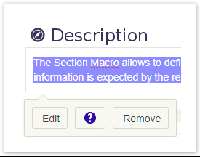...
| Document Properties Marker | |||||||||||||||||||||||||||||||||||||||||||||||||||||
|---|---|---|---|---|---|---|---|---|---|---|---|---|---|---|---|---|---|---|---|---|---|---|---|---|---|---|---|---|---|---|---|---|---|---|---|---|---|---|---|---|---|---|---|---|---|---|---|---|---|---|---|---|---|
| |||||||||||||||||||||||||||||||||||||||||||||||||||||
|
| Section | ||||
|---|---|---|---|---|
| ||||
A template typically puts a demand on the author: fill out everything! Or remove what you did not fill out now! Neither is appreciated. The authors have a set of information in their minds they want to contribute. Maybe the document is created collaboratively. Certainly it is created iteratively. This especially applies to project documentation, where the team writes for the team. In this case the documentation is typically never finished. Rather the documents are in different states of the iteration cycle. Yet the information provided is already relevant for other team members. Do we want our readers to be confronted with empty sections only attached to a decoy title? Do we add value by some decoy text like "TBD"? On the other hand, if the boiler plate parts are removed, we have no access to them when we or other teammates need it. The result of this feature is that an author is provided with support adding relevant information at the expected positions and also has guidance according to what information may be relevant for my audience for this kind of document. On the other hand the reader is only seeing section with actual content. The same is true for properties.
As a screenshot this feature looks like this: In edit mode the authors have access to the structure that is defined by the template. The authors decide which information they need to add to the document and stores it at the defined locations. They may add any number of additional properties or sections. Any properties or sections that are not yet (or never relevant), are left empty. Once the document is saved, only those properties and sections are presented to the reader that actually contain relevant information. On the left side there is the view of an editor with sections that have content or have no content. On the right side you see what reader's see in view mode. Sections with no content are not rendered. The Section Macro allows to define possible information for a given doctype at a defined position within the document. Typically this section contains text supporting the author to know which information is expected by the reader for each section. The Section Macro also allows to link to more information by the use of the help button (marked with the image of a question mark ). |
...





